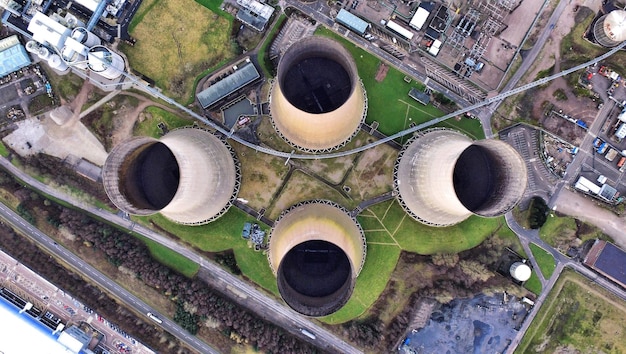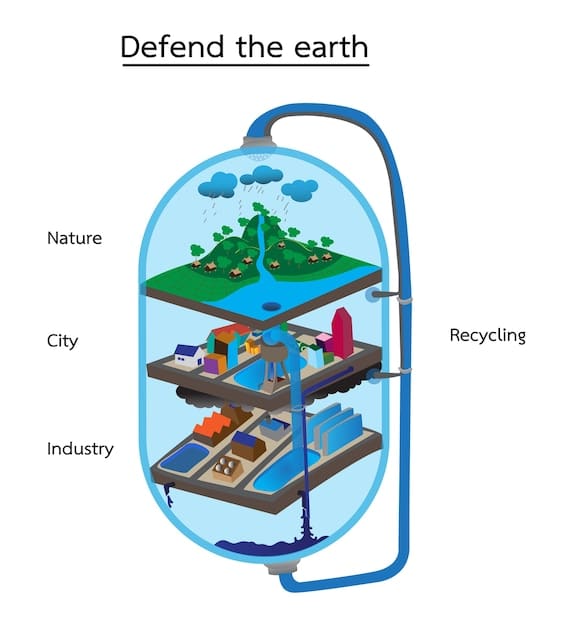Federal Tax Incentives for Carbon Capture: Latest Developments

Recent developments in federal tax incentives for carbon capture and sequestration (CCS) technologies in the U.S. include enhancements to the 45Q tax credit and increased funding for CCS projects, aiming to accelerate deployment and reduce carbon emissions.
The landscape of federal tax incentives for carbon capture and sequestration (CCS) technologies is constantly evolving. Understanding the latest developments is crucial for businesses and stakeholders involved in clean energy initiatives. Let’s delve into the recent changes and what they mean for the future of carbon capture in the United States.
Understanding Carbon Capture and Sequestration (CCS)
Carbon capture and sequestration (CCS) is a set of technologies aimed at preventing large quantities of carbon dioxide (CO2) from being released into the atmosphere. These technologies involve capturing CO2 from emission sources, such as power plants and industrial facilities, and storing it underground. Understanding the basics of CCS is essential context for exploring the latest tax incentives.
The CCS process typically includes three main stages: capturing CO2 from the source, transporting the captured CO2, and storing it permanently in deep geological formations. Various methods exist for capturing CO2, including pre-combustion capture, post-combustion capture, and oxy-fuel combustion. Each method has its own advantages and disadvantages, depending on the specific application and emission source.

Benefits of CCS Technologies
CCS technologies offer huge advantages. Let’s take a look at some of them.
- Reduced Greenhouse Gas Emissions: By capturing CO2 emissions from industrial sources and storing them, CCS technologies substantially reduce greenhouse gas emissions, contributing to climate change mitigation efforts.
- Supports Energy Security: CCS allows for the continued employment of fossil fuels with decreased environmental damages.
- Economic Opportunities: The advancement and employment of CCS offers chances for technological advancement and investment.
In conclusion, CO2 capture and storage (CCS) involves capturing CO2 and keeping it underground, which helps to significantly lower greenhouse gas emissions. It supports energy security and provide new economic opportunities.
The 45Q Tax Credit: An Overview
The 45Q tax credit is a federal incentive designed to support carbon capture and sequestration projects in the United States. Enacted in 2008 and significantly enhanced by the Bipartisan Budget Act of 2018, the 45Q tax credit provides financial benefits to companies that capture and store CO2. Gaining an overview of the 45Q tax credit is vital to fully understand the latest developments.
This tax credit can be claimed for each metric ton of qualified carbon oxide that is captured and either securely stored in geological formations or used for enhanced oil recovery (EOR). The amount of the credit depends on the method of carbon storage or utilization.
Eligibility Criteria for 45Q
To be eligible for the 45Q tax credit, CCS projects must meet certain criteria. Here are the key requirements:
- Qualified Facility: The carbon capture project must occur at a qualified facility, which includes industrial facilities and direct air capture (DAC) facilities.
- Carbon Capture Thresholds: The facility must capture specific amounts of CO2 annually: 500,000 metric tons for electricity generating facilities, 25,000 metric tons for other industrial facilities, and 1,000 metric tons for DAC facilities.
- Secure Geological Storage: Captured CO2 must be securely stored in geological formations following EPA regulations or used for EOR in compliance with established standards.
In summary, the 45Q tax credit has been set by the federal government to encourage carbon capture and sequestration initiatives in the US. The amount of the credit depends on the technique used to store or use carbon, and there are many eligibility conditions.
Recent Enhancements to the 45Q Tax Credit
Several recent developments have enhanced the 45Q tax credit, making it more appealing and accessible to businesses involved in CCS projects. These enhancements aim to stimulate investment and accelerate the deployment of carbon capture technologies. Let’s take a look at the biggest enhancements to the tax credit.
The Inflation Reduction Act of 2022 (IRA) introduced important changes to the 45Q tax credit, including increased credit values, reduced capture thresholds, and extended deadlines. These adjustments are designed to make CCS projects more financially viable and encourage a wide range of industries to adopt carbon capture technologies.

Key Changes Under the Inflation Reduction Act
The Inflation Reduction Act (IRA) is an important update to keep in mind when you are looking into the different tax advantages of CCS deployment.
- Increased Credit Values: The IRA raised the credit value for secure geological storage to \$85 per metric ton and for enhanced oil recovery to \$60 per metric ton.
- Reduced Capture Thresholds: Minimum annual carbon capture amounts were lowered to 12,500 metric tons for electricity generating facilities, 1,000 metric tons for industrial facilities, and 1,000 metric tons for DAC facilities.
- Extended Credit Availability: Projects that begin construction before January 1, 2033, are now eligible for the 45Q tax credit, expanding the timeframe for project development.
In short, recent improvements to the 45Q tax credit, particularly those of the Inflation Reduction Act include raised credit values, lower capture thresholds, and longer deadlines. These steps encourage greater investment and faster use of carbon capture technologies.
Impact on Carbon Capture Project Economics
The recent enhancements to the 45Q tax credit have a substantial impact on the economics of carbon capture projects. By increasing the credit values and reducing capture thresholds, the financial viability of CCS projects has improved significantly. To understand the overall impact, let’s take a peak at these impacts.
Higher credit values mean that CCS projects can generate more revenue per ton of CO2 captured and stored, resulting in improved project returns. Lower capture thresholds enable smaller industrial facilities and DAC projects to qualify for the tax credit, broadening the scope of eligible projects.
The economic advantages of the updated 45Q tax credit are many.
- Improved Return on Investment: The higher credit values boost the return on investment for CCS projects, which makes them more attractive to investors.
- Increased Project Viability: Lowering the capture thresholds enables a bigger range of industrial facilities to take part in carbon capture initiatives.
- Stimulated Innovation: The prospect of generous tax credits drives technical innovation in carbon capture, which results in more effective and inexpensive options.
To summarize, advances in the 45Q tax credit greatly affect the economics of carbon capture projects, enhanced returns on investment, greater project viability, and the encouragement of technical development. All of this makes investment in carbon capture technologies much more appealing.
Other Federal Funding and Incentive Programs
In addition to the 45Q tax credit, several other federal funding and incentive programs support the development and deployment of carbon capture and sequestration technologies. These programs provide additional financial assistance, technical support, and research opportunities to promote CCS projects. Let’s explore the additional incentives.
The Department of Energy (DOE) offers grant programs, loan guarantees, and cooperative agreements to support CCS research, development, and demonstration projects. These programs aim to advance innovative carbon capture technologies, reduce the cost of CCS, and accelerate the deployment of carbon capture projects across different industries.
DOE Initiatives for CCS
The DOE has helped numerous CCS projects. These programs promote technological improvement, cost reductions, and broad adoption of carbon capture across different industries.
- Carbon Capture Demonstration Projects Program: Aims to advance and validate innovative carbon capture technologies through large-scale pilot and demonstration projects.
- Carbon Storage Assurance Facility Enterprise (CarbonSAFE) Initiative: Focuses on developing and validating secure carbon storage sites across the United States.
- Advanced Research Projects Agency-Energy (ARPA-E): Supports high-risk, high-reward research projects aimed at developing breakthrough carbon capture technologies.
In conclusion, various programs, including those managed by the Department of Energy (DOE), supplement the 45Q tax credit in promoting CCS technology innovation and use. These initiatives offer essential financial, technical, and research assistance intended to boost CCS project implementation.
Challenges and Opportunities for CCS Deployment
While federal tax incentives and funding programs offer vital support for carbon capture and sequestration technologies, various challenges and opportunities still exist for widespread CCS deployment. Being aware about these issues is vital for CCS deployment.
High capital costs, regulatory uncertainties, and public acceptance concerns represent significant obstacles to CCS deployment. Overcoming these challenges requires technological advancements, supportive policies, and proactive community engagement.
Addressing such challenges and maximizing the opportunities depends on innovation and stakeholder support.
- Technological Innovation: Further advancements in carbon capture technologies are needed to reduce costs and improve efficiency.
- Policy Support: Clear and consistent regulatory frameworks are essential to provide certainty and encourage investment in CCS projects.
- Public Engagement: Educating the public about the benefits of CCS and addressing concerns related to safety and environmental impacts is crucial for gaining public support.
In summary, even with federal tax incentives supporting carbon capture and sequestration (CCS) technologies, a number of issues and possibilities are still present for widespread CCS implementation such as dealing with high expenses and regulatory ambiguity. For CCS to be implemented effectively worldwide, technological progress, supportive policies, and community involvement are all required.
| Key Point | Brief Description |
|---|---|
| 💰45Q Tax Credit | Federal incentive supporting carbon capture and sequestration projects. |
| ⬆️IRA Enhancements | Increased credit values and lowered capture thresholds through Inflation Reduction Act. |
| 🏢DOE Programs | DOE offers grants and agreements for CCS research and deployment. |
| 🚧Challenges | High costs and regulatory uncertainties limit CCS deployment. |
Frequently Asked Questions (FAQ)
▼
The 45Q tax credit is a federal incentive for carbon capture and sequestration (CCS) projects. It provides a credit for each metric ton of qualified carbon oxide captured and securely stored or used for enhanced oil recovery, aiming to reduce carbon emissions.
▼
The Inflation Reduction Act increased the credit values for secure geological storage and enhanced oil recovery. It also lowered the minimum annual carbon capture amounts required and extended the eligibility timeframe for projects.
▼
Eligible projects include those at qualified facilities like industrial facilities, electricity generating facilities, and direct air capture facilities. They must meet certain annual carbon capture thresholds and comply with secure storage or utilization standards.
▼
The Department of Energy (DOE) offers grant programs, loan guarantees, and cooperative agreements to support CCS research, development, and demonstration projects. These aim to advance and validate innovative carbon capture technologies.
▼
Challenges include high capital costs and public acceptance. Opportunities include technological innovation that reduces costs and more consistent regulations. Furthermore, engaging the public about the technologies can help ensure widespread use.
Conclusion
In conclusion, the latest developments in federal tax incentives for carbon capture and sequestration technologies present a promising pathway for reducing carbon emissions and mitigating climate change. With enhancements to the 45Q tax credit and the availability of other federal funding programs, businesses have increased opportunities to invest in and deploy CCS projects. Overcoming these challenges and fully leveraging these incentives requires continued innovation, policy support, and stakeholder collaboration to unlock the full potential of CCS technologies and create sustainable environmental outcomes.





